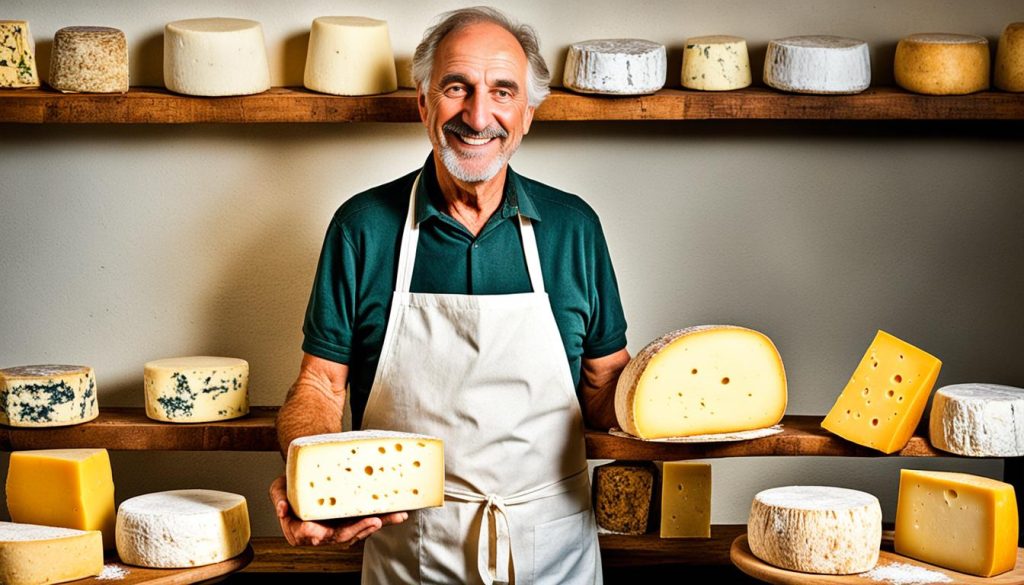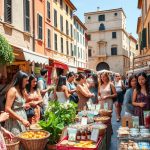Cheese making in Italy goes back centuries. It’s a tradition that has been passed down through generations. From Tuscany’s hills to Campania and Lombardy’s beauty, Italian cheese makers are proud of their craft. They make some of the world’s finest cheeses.
For Italians, cheese making is more than a skill; it’s a way of life. They use fresh milk from local farms. The process shows their dedication and skill, creating cheeses full of flavor and character.
Italian cheese making stands out because of its regional varieties. Each region has its own cheese specialties. These are shaped by the local land, climate, and traditional ways. You can find everything from creamy mozzarella to sharp pecorino romano.
Artisan cheese making in Italy is about more than making cheese. It’s about keeping a cultural heritage alive. These traditional techniques have been in families for generations. This keeps the knowledge and skills alive.
Key Takeaways:
- Italian cheese making traditions have a long history, with techniques passed down through generations.
- Regional varieties of Italian cheese offer a diverse range of flavors and textures.
- Artisan cheese makers in Italy prioritize quality ingredients and traditional methods.
- Preserving Italian cheese making heritage is an essential part of the craft.
- Italian cheeses are renowned for their exceptional flavors and unique characteristics.
The History of Italian Cheese Making
Italian cheese making has a long and rich history. It goes back to ancient times. Back then, cheese making traditions started and were kept alive through generations.
These traditions have evolved over time. Italian cheese makers have perfected ancient techniques. This has led to the wide variety of cheeses we know and love today.
In ancient times, making cheese was crucial in Italian culture and food. It helped communities use excess milk and keep it for later. So, cheese making became a big part of daily life and traditions. Each region developed its own unique way of making cheese.
Old cheese making used enzymes from animals’ stomachs, like rennet, to curdle milk. The curds were then separated from the whey and shaped. The cheeses were aged and cured, which made them taste complex and develop unique textures.
The Evolution of Italian Cheese Making
Over time, Italian cheese making changed. New ingredients, methods, and tools were introduced. Better cheese presses and starter cultures improved the process.
During the Renaissance, Italian cheese making reached new heights. Cheese making guilds formed, with strict rules to make top-quality cheeses. These guilds helped keep Italian cheeses’ reputation high, setting standards still followed today.
Today, Italian cheese making traditions are still alive. They keep ancient techniques and recipes going. Italy is famous for its many traditional cheeses, each with its own taste and way of making.
| Cheese | Region | Texture | Flavor |
|---|---|---|---|
| Parmigiano Reggiano | Emilia-Romagna | Hard | Nutty, savory |
| Mozzarella di Bufala | Campania | Soft | Mild, creamy |
| Pecorino Romano | Lazio | Hard | Salty, sharp |
| Gorgonzola | Lombardy | Blue-veined | Rich, tangy |
Italian cheese making is a true art. It combines tradition, skill, and passion. The history and heritage of each cheese make it special. Exploring Italian cheeses lets us see the long traditions and the hard work of the cheese makers.
Regional Varieties of Italian Cheese
Italy is famous for its rich history and vibrant culture. It’s also known for its diverse range of regional Italian cheese varieties. Each region has its own Italian cheese specialties. These cheeses are loved for their unique flavors, textures, and how they’re made.
The North:
In the north, you’ll find a variety of famous Italian cheeses. Lombardy is known for its creamy Gorgonzola cheese. Emilia-Romagna is famous for Parmigiano Reggiano and Grana Padano. Piedmont is home to the unique Taleggio cheese, with its soft texture and tangy taste.
The Center:
Moving to the central regions, we find more Italian cheese specialties. Tuscany is known for its rich Pecorino Toscano. Umbria is famous for its smooth Fiore Sardo. Lazio is where you’ll find the popular Bufala Mozzarella, made from buffalo milk.
The South:
Heading south, Campania and Basilicata offer a range of regional Italian cheese varieties. Campania is home to Provolone del Monaco, a firm cheese with a smoky hint. Basilicata has the unique Caciocavallo Podolico, made from Podolica cow’s milk.
When talking about Italian cheese, you can’t forget the iconic mozzarella di bufala from Campania and the Gorgonzola from Lombardy. These cheeses are loved worldwide for their quality and taste.
Whether you like mild and creamy cheeses or strong and aged ones, exploring regional varieties of Italian cheese is a journey through Italy’s diverse flavors.
Traditional Cheese Making Techniques in Italy
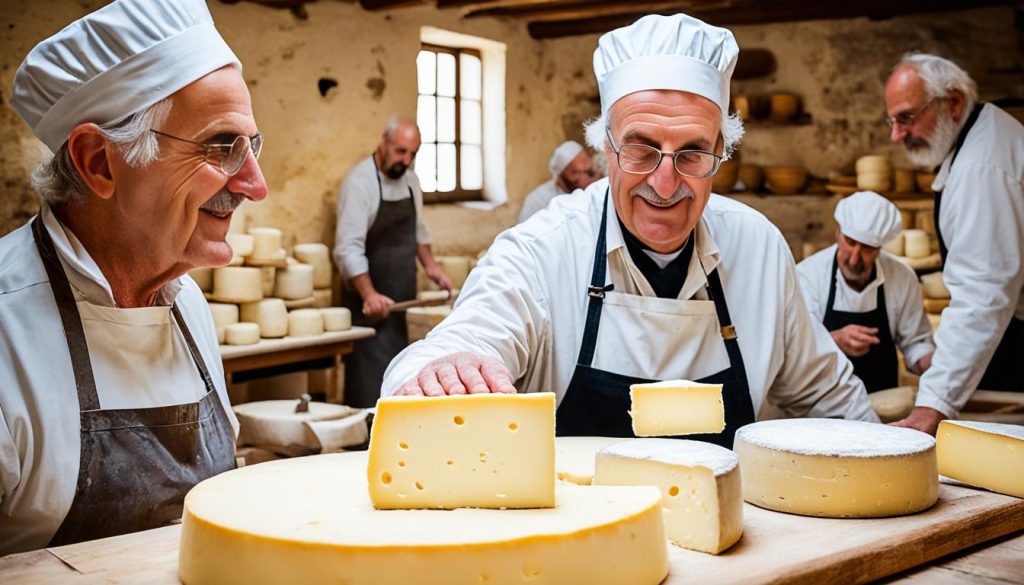
In Italy, cheese making is a tradition that goes back generations. It keeps traditional methods alive, making Italian cheeses unique in quality and taste. These methods, unchanged for centuries, are key to Italy’s cheese-making heritage. They guide the artisanal cheese production today.
Milk Selection and Curdling
Choosing the right milk is crucial in cheese making. Italian makers use top-quality milk from local farms. This choice affects the cheese’s taste and texture. The milk is checked carefully to meet the required standards.
After collecting the milk, it’s curdled. Artisans use natural methods, often with rennet from young calves’ stomachs. This makes the cheese taste complex.
Shaping and Pressing
Once curdled, the curds are separated from the whey. They are then shaped into various forms, depending on the cheese type. Making the cheese involves detailed manual work. This includes cutting the curds by hand, molding them, and pressing to dry them.
Maturing and Aging
Maturing and aging are key steps in Italian cheese making. They help develop the unique flavors and textures of each cheese. The cheese is kept in controlled rooms or caves during this time. Aging can last from weeks to months, depending on the cheese type.
The Art of Italian Cheese Making
Italian cheese making is more than just old techniques. It’s about the skill and knowledge artisans use. Each region has its own way of making cheese, leading to a wide variety. From the sharp Pecorino Romano to the creamy Mozzarella, the craftsmanship is amazing.
Section 4 explores traditional Italian cheese making. It covers the steps from milk selection to aging. These steps are vital for making exceptional, artisanal cheeses. They’re what make Italian cheese so renowned.
PDO and PGI Italian Cheeses
Protected Designation of Origin (PDO) and Protected Geographical Indication (PGI) certifications are key. They help keep Italian cheeses authentic, high quality, and true to their traditional ways of making. These certifications make sure the cheese’s identity and where it comes from are safe.
PDO Italian cheeses are made in certain areas using old methods and ingredients. The rules for PDO cheeses make sure every step of making the cheese, from getting the milk to aging it, follows the traditional ways of that area. This makes the cheese taste like its region.
PGI Italian cheeses also link to their place of origin and have unique traits from traditional making. The rules for PGI cheeses are not as strict as for PDO, but they still ensure the cheese is real and connected to its region.
These certifications mean consumers know they’re eating true Italian cheese with amazing taste and quality. The PDO and PGI labels show the cheese is made in a traditional way. This reflects Italy’s rich cheese-making culture and history.
The table below shows some famous PDO and PGI Italian cheeses and where they come from:
| Cheese | PDO/PGI | Region |
|---|---|---|
| Parmigiano Reggiano | PDO | Emilia-Romagna |
| Mozzarella di Bufala Campana | PDO | Campania |
| Pecorino Romano | PDO | Lazio |
| Gorgonzola | PDO | Lombardy and Piedmont |
| Grana Padano | PDO | Various regions in Northern Italy |
| Caciocavallo Silano | PDO | Calabria, Campania, and Basilicata |
| Asiago | PDO | Veneto and Trentino-Alto Adige |
| Fiore Sardo | PDO | Sardinia |
These cheeses show the wide range and richness of Italian cheese making. Each region has its own special cheeses and tastes. When you try a PDO or PGI Italian cheese, you’re enjoying the true taste of a region’s cheese traditions.
Famous Italian Cheese Regions
Italy is famous for its cheese-making traditions. These traditions have shaped the country’s culinary heritage. Let’s explore some of the most famous Italian cheese regions and their unique traditions.
Emilia-Romagna: Home of Parmigiano-Reggiano
Emilia-Romagna is in Northern Italy and is where Parmigiano-Reggiano was born. This cheese is made from raw cow’s milk. It’s aged for at least 12 months, giving it a rich, nutty taste and a crumbly texture.
The making of this cheese follows old traditions. Skilled craftsmen work hard to make sure each wheel of Parmigiano-Reggiano is perfect.
Lombardy: The Birthplace of Grana Padano
Lombardy is in the north and is known for Grana Padano. Like Parmigiano-Reggiano, it’s a hard cheese from cow’s milk, aged for at least 9 months. It has a delicate and creamy taste, making it great for many dishes.
The traditions of making cheese in Lombardy have been kept alive for generations. This has helped keep Grana Padano’s unique taste.
Tuscany: Pecorino Cheese from the Rolling Hills
Tuscany is known for its beautiful landscapes and Pecorino cheese. This cheese comes from sheep’s milk and can taste and feel different depending on where it’s made. Pecorino Romano is sharp and salty, while Pecorino Toscano is milder.
The making of Pecorino cheese in Tuscany reflects the area’s farming history. Local shepherds play a big part in making this loved Italian cheese.
Campania: Mozzarella di Bufala from the Italian South
Campania is famous for Mozzarella di Bufala, a soft and creamy cheese from water buffalo milk. It’s perfect for the Caprese salad because of its delicate texture and mild taste. Making Mozzarella di Bufala in Campania focuses on quality buffalo milk and careful craftsmanship.
Sardinia: The Land of Pecorino Sardo
Sardinia is an island with its own cheese traditions, especially Pecorino Sardo. This cheese can be young or aged, changing its flavor and texture. Young Pecorino Sardo is smooth, while aged ones are sharper and nuttier.
The cheese-making in Sardinia is part of the island’s farming history. It makes a cheese that truly represents the region.
These regions show the diversity of Italian cheese-making. Each region has its own traditions that add to Italy’s cheese culture. Enjoying a piece of Parmigiano-Reggiano or Mozzarella di Bufala lets you taste centuries of tradition.
Artisanal vs. Industrial Cheese Production
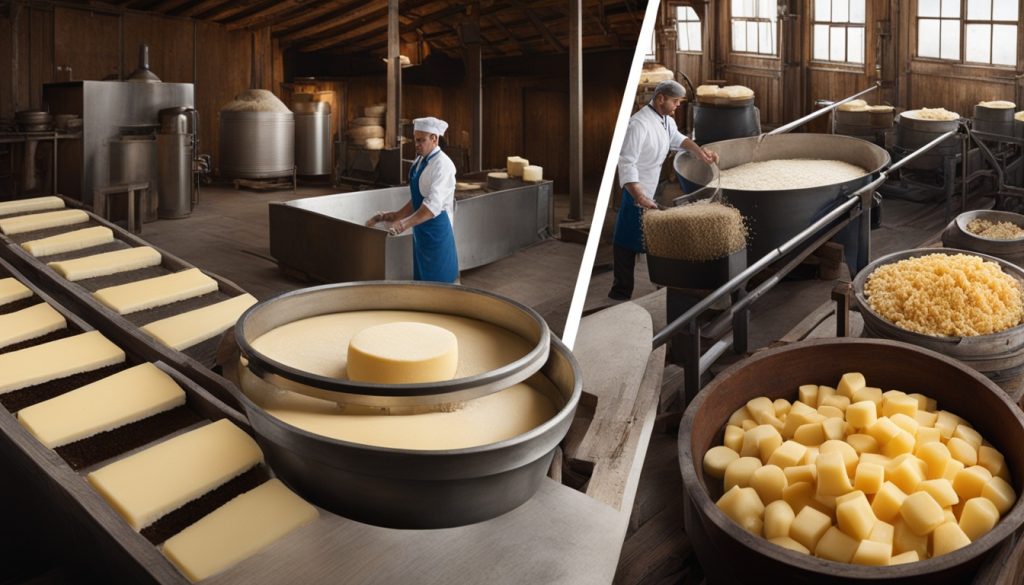
Italy is famous for its cheese traditions and wide variety. From Tuscany’s hills to Emilia-Romagna’s countryside, artisans have made cheese for centuries. They keep the art alive.
Artisanal cheese making is a craft of love. Skilled craftsmen use old methods passed down through families. They focus on quality, not quantity, making exceptional cheeses. The process is detailed, with small batches, chosen ingredients, and deep knowledge.
Industrial cheese making is all about efficiency and big production. New technology and methods let them make a lot of cheese fast and cheap. But, this can change the traditional taste and feel of cheese.
The Significance of Traditional Cheese Making
Traditional cheese making is very important in Italy. It keeps the unique tastes and traits of each cheese. Artisans use raw milk, which makes the cheese taste better over time.
They also care about the animals, getting milk from small farms. This milk is better quality, without bad additives found in some industrial cheeses.
Challenges Faced by Modern Cheese Makers
Industrial cheese making has its upsides, like being efficient and meeting demand. But, it has its downsides. Using pasteurized milk changes the cheese’s taste. And, it often uses additives, making the cheese less unique.
Some modern makers are trying to mix old ways with new. They want to keep the real taste and heritage of Italian cheeses.
The image above shows the difference between making cheese the old way and the new way. It highlights the scale, methods, and focus on details of each approach.
The Role of Milk in Italian Cheese Making
Italian cheeses rely heavily on the quality of the milk used. This milk quality impacts the cheese’s taste, texture, and overall quality. It’s a key factor in making top-notch Italian cheeses.
Importance of Milk Quality in Cheese Production
Cheese making milk is crucial for success. It affects the cheese’s flavor, aroma, and consistency. Italian cheese makers know that the best milk is essential for making cheeses loved worldwide.
They focus on using milk from healthy animals. They choose specific cow, goat, or sheep breeds for their high-quality milk. These breeds are picked for their fat content, protein levels, and flavor.
Italian Milk for Cheese Making
Italian cheese making often uses milk from traditional breeds. For example, Parmigiano Reggiano uses milk from Vacche Rosse (Red Cows). This milk gives Parmigiano Reggiano its rich flavors.
Goats and sheep also contribute to Italian cheese making. Goat’s and sheep’s milk add unique flavors and textures. Pecorino Romano, a famous cheese, is made from sheep’s milk and is known for its sharp taste.
The Art of Cheese Making Milk Selection
Italian cheese makers are very careful in choosing their milk. They look for the best quality, considering hygiene, freshness, and nutrition. This ensures the milk is top-notch for cheese making.
The type of milk used is key to the cheese’s characteristics. Whether it’s the creamy Mozzarella di Bufala Campana or the smooth Gorgonzola, the milk quality is crucial.
The Harmonious Combination of Milk and Tradition
In Italian cheese making, milk is the heart of the cheese. The blend of premium milk and traditional techniques creates the unique flavors and textures of Italian cheeses.
| Cheese | Milk Source | Characteristic |
|---|---|---|
| Parmigiano Reggiano | Vacche Rosse (Red Cows) | Rich, nutty flavor |
| Mozzarella di Bufala Campana | Water Buffalo | Creamy, delicate texture |
| Gorgonzola | Cow’s milk | Soft, blue-veined, tangy taste |
| Pecorino Romano | Sheep’s milk | Sharp, salty flavor |
Traditional Cheese Aging and Maturing
In Italian cheese production, aging and maturing are key steps. They make the cheese’s flavors and textures unique. These processes let the cheese’s flavors grow and get stronger over time. This creates a special taste experience for cheese fans.
Italian cheese maturation uses specific conditions like temperature and humidity. These conditions help improve the cheese’s flavors and textures. This results in a wide range of Italian cheeses, each with its own characteristics.
‘Stagionatura’ is a popular aging method in Italian cheese making. It involves aging the cheese for months or even years. During this time, the cheese changes naturally, thanks to its environment. This method creates complex and deep flavors that cheese lovers love.
Aging Techniques and Their Impact
Let’s look at the aging techniques used in Italian cheese production. These include:
- Air Drying: Some cheeses, like Parmigiano Reggiano, are dried in the air for a long time. This makes them hard and gives them a crystalline texture.
- Cave Aging: Many Italian cheeses are aged in caves. The cave’s conditions help shape the cheese’s taste and smell.
- Brine Bath: Cheeses like Pecorino Romano are soaked in brine before aging. This controls moisture and adds a salty taste.
- Seasonal Aging: Cheeses like Fontina are aged in specific seasons. This gives them unique flavors and textures.
These aging techniques show the skill and knowledge of Italian cheese makers. They have perfected these methods over many years.
Aging and Maturation Examples
Here are some examples of traditional cheese aging and maturing:
| Cheese | Aging Technique | Characteristics |
|---|---|---|
| Gorgonzola | Cave Aging | Rich and creamy with blue veins and a tangy flavor |
| Pecorino Toscano | Air Drying | Firm texture, nutty flavor, and slightly salty notes |
| Taleggio | Brine Bath and Cave Aging | Soft, gooey texture with a pungent aroma and buttery, tangy taste |
These examples show the amazing variety in Italian cheese aging and maturing. Each cheese has its own special identity. This comes from the local traditions, nature, and the skill of the cheese makers.
Italian Cheese Pairings and Culinary Uses
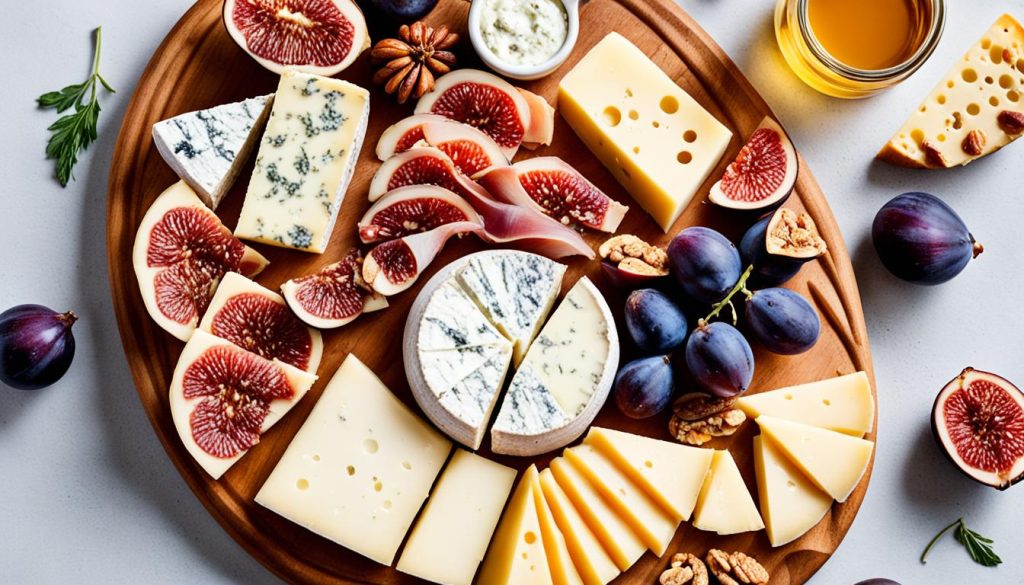
Explore the art of pairing Italian cheeses with other flavours to boost your cooking. From classic wine and fruit pairings to adding cheese to traditional dishes, there’s much to discover.
Recommended Pairings
Choosing the right cheese pairings is key. Each cheese has its own unique taste. Here are some top tips to enhance your meals:
- Pair Parmigiano-Reggiano with a full-bodied red wine or sweet grapes for a great contrast.
- Mozzarella di Bufala is perfect with fresh tomatoes and basil, making the famous Caprese salad.
- Try Pecorino Toscano with honey and pears for a taste of Tuscany.
- Gorgonzola goes well with crusty bread and Port wine, thanks to its creamy texture and rich taste.
- Grana Padano pairs well with prosciutto and Prosecco, balancing saltiness and bubbles.
Italian Cheese in Cooking
Italian cheeses are great for more than just pairings. They add depth and flavour to many dishes. Here’s how to use them in your cooking:
- Add Parmigiano-Reggiano to pasta, risottos, and salads for a burst of flavour.
- Melt Mozzarella or Fontina on pizzas, lasagnas, or sandwiches for a cheesy treat.
- Use Ricotta in desserts like cannoli or as a filling for ravioli and gnocchi.
- Enhance creamy pasta sauces, soups, or stuffed mushrooms with Gorgonzola or Asiago.
- Grate Pecorino Romano over roasted veggies or season meat dishes for extra flavour.
Italian cheeses are perfect for cheese platters, pasta dishes, or new flavour experiments. They add a delicious touch to any meal.
Sustainable Cheese Production in Italy
The Italian cheese industry values sustainable practices and eco-friendly methods. These producers aim to lessen their environmental impact and help local communities. They use new ideas and old wisdom to make a greener future.
Implementing Sustainable Cheese Making Practices
Italian cheese makers focus on reducing their environmental footprint. They use organic farming and manage waste responsibly. This helps protect natural resources and supports a balance with nature.
They’re turning to renewable energy like solar and wind power. This cuts down on non-renewable energy use and lowers emissions. Using sustainable energy helps reduce their carbon footprint and makes production cleaner.
Eco-Friendly Cheese Production
Eco-friendly cheese making means being mindful at every step. They buy ingredients from local farmers to help the economy and cut down on emissions. They choose natural ingredients and avoid synthetic additives for healthier cheese.
They’re also working to use less water. By using water-saving tech and efficient irrigation, they can cut down on water use. This helps conserve this vital resource.
Reducing the Environmental Impact of Cheese Making
Italian cheese producers work hard to lessen their environmental impact. They use recycling and composting to reduce waste and invest in better wastewater treatment. These efforts help protect the environment and keep ecosystems safe.
They’re also focusing on sustainable packaging. Using materials that can biodegrade or be recycled helps cut down on plastic waste. This shows their commitment to being eco-friendly.
| Initiatives | Benefits |
|---|---|
| Adoption of renewable energy sources | Reduction in greenhouse gas emissions and carbon footprint |
| Supporting local farmers | Stimulates local economies and reduces transportation emissions |
| Water-saving technologies | Minimized water consumption and conservation of resources |
| Waste reduction strategies | Decreased pollution and preservation of local ecosystems |
| Eco-friendly packaging | Reduced plastic waste and improved environmental sustainability |
Italian cheese makers are always looking for new ways to be more eco-friendly. By focusing on sustainability and cutting down their environmental impact, they’re leading the way to a greener future.
Italian Cheese Making Traditions in Modern Times
Italian cheese making has a long history filled with tradition. Yet, it has also changed to use new techniques and technology. Now, old ways and new methods have created a new era in Italian cheese making.
Modern Italian cheese making now uses advanced equipment and machinery. Traditional methods are still important, but new tech helps make production better. This mix keeps the traditional feel while making things more efficient.
New cheese making techniques have changed the industry too. Cheese makers try new methods and ingredients to make unique tastes and textures. These new ways have brought more Italian cheeses to the market and attracted cheese lovers from around the world.
Today, Italian cheese production also focuses on being green. Many cheese makers use milk from local, organic farms. This ensures top quality and connects them to their land and people. They also use systems to manage waste and energy-efficient tech to lessen environmental harm.
In conclusion, modern Italian cheese making mixes old traditions with new technology. This mix leads to amazing cheeses that capture the true taste of Italy. As the industry grows, we’re excited to see the new innovations and changes in Italian cheese making.
Preserving Italian Cheese Making Heritage
Keeping the art of cheese making alive is key to protecting Italy’s rich cultural traditions. Italian cheese making has a long history, with each region having its own unique way of doing things. It’s vital to support small-scale artisanal cheese makers to keep these traditions going.
The cultural value of Italian cheese is something we must hold dear. These cheeses let us taste Italy’s diverse food scene. They also show the skill and hard work of dedicated cheese makers. By valuing Italian cheeses, we help keep this cultural heritage alive.
Supporting artisanal cheese makers is a great way to help preserve Italian cheese making. When we choose and enjoy their products, we’re not just getting great taste. We’re also helping the artisans who make it possible. This choice helps keep their traditions and livelihoods going.
Let’s celebrate the cultural importance of Italian cheeses and the skill of those who make them. By supporting artisanal cheese makers, we make sure future generations can enjoy these unique tastes and traditions too.

